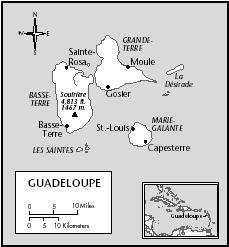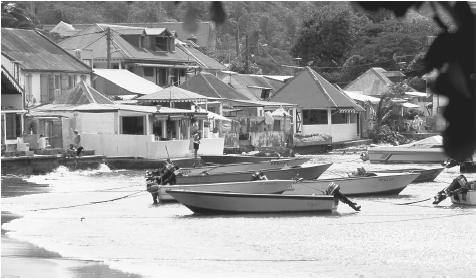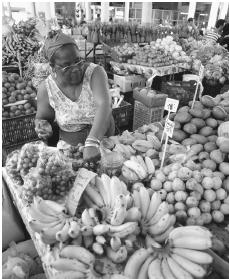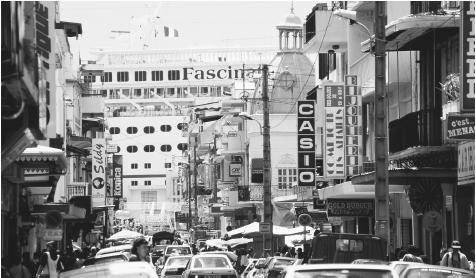Guadeloupe
Culture Name
Guadeloupean
Alternative Names
Before its discovery by Christopher Columbus in 1493, the island was called Karukera ("island of beautiful waters") by the Caribs.
Orientation
Identification. Columbus named the island after the Spanish sanctuary Santa Maria de Guadalupe de Estremadura.
Location and Geography. Guadeloupe is an archipelago of eight inhabited islands in the Lesser Antilles, between the tropical Atlantic and the Caribbean Sea. The two principal islands, Basse-Terre and Grande-Terre, are separated by a channel, the Rivière Salée. The capital, Basse-Terre, is on the western wing; the commercial center, Pointe-á-Pitre, is on the eastern wing. The other islands, known as "dependencies," are Marie-Galante, la Désirade, Petite-Terre (uninhabited), and the archipelago Les Saintes, along with Saint Barthélemy and the northern half of Saint Martin to the north. The total area is 660 square miles (1,705 square kilometers). Grande-Terre, essentially limestone, consists of plateaus, plains, and hills ( mornes ). Basse-Terre is volcanic with high mountains and a tropical rain forest. The climate is humid and tropical with a dry season from January to May and a wet season from June to December.
Demography. The total population in 1997 was estimated to be 428,044 with a density of 650 inhabitants per square mile (251 per square kilometer) and a growth rate of 1.5 percent annually. Until recently, population growth was steady because of high levels of fertility and declining mortality as a result of better hygiene and medicine. The youth of the population and high unemployment situation spurred government attempts to control the population through subsidized family-planning programs and a policy of emigration in the period 1961–1981. The majority of the population is of African descent, with a substantial East Indian minority and smaller groups of Syro-Lebanese and white Creoles ( blancs-pays ). In the outlying island dependencies there are distinctive white populations in La Désirade and Saint-Barthélemy and light-skinned inhabitants in Les Saintes.
Linguistic Affiliation. French is the official language of administration and education, but Guadeloupeans speak a French-lexified Creole that dates back to the time of colonization and slavery. In the 1970s and 1980s, Creole became a critical symbol in the nationalist claim for independence from France. Today all social strata recognize the value of Creole in cultural revitalization. Other languages play symbolic roles for ethnic minorities. Syro-Lebanese residents frequently listen to Arabic-language radio stations, and songs and prayers in Tamil have survived in Hindu religious ceremonies.
Symbolism. Creole, drum music, food specialties, and the celebration of carnival operate alongside symbols of the French hegemonic presence such as the tricolor flag and the French national anthem.
History and Ethnic Relations
Emergence of the Nation. In the pre-Columbian period, Arawaks and later Caribs moved to the region from coastal South America. European exploration led to conquest, to colonization, to the eradication of the indigenous population, to the introduction of sugarcane cultivation, and a plantation economy that was dependent on African slave labor. Under French colonial domination since 1635, with brief periods of English occupation, Guadeloupe was shaped by French politics. The first abolition of slavery (1794–1802) and the almost total elimination of the white plantocracy during

During the twentieth century, the local population of color sought to redress political, social, and economic inequalities. With the passage of the Assimilationist Law on 19 March 1946, Guadeloupe became an overseas department of France. This process ushered in wide-scale transplantation of French administrative and political superstructures and educational and social security systems. Integration with France precipitated a decline in both export and subsistence agriculture, a growth in the service sector, a rise in unemployment, massive emigration, and increasing tensions between Guadeloupeans and metropolitan French. In 1974, Guadeloupe was designated a region, ushering in a policy of decentralization.
National Identity. The revolutionary hero Louis Delgrès, who committed suicide in 1802 rather than be subjugated to the restoration of slavery, is credited with starting the formation of a national consciousness. The first independence movements had their origins in Antillean student organizations in France and the decolonization movement after World War II. The Groupe d'Organisation Nationale de la Guadeloupe was formed in the mid-1960s; in the early 1970s the independentist party—the Union pour la Libération de la Guadeloupe—was founded, and in 1981 the Mouvement Populaire pour une Guadeloupe Indépendante was created. Nationalist activity has focused on political demonstrations, trade-union strikes, electoral abstention, and affirmations of cultural difference. The marginal support nationalists enjoyed in the 1980s has eroded with decentralization.
Ethnic Relations. Relations between the black majority and the East Indian minority are basically devoid of tension. Politics and culture remain arenas of debate as a result of increased French integration and the growing presence of the European Union.
Urbanism, Architecture, and the Use of Space
Colonialism created different levels of culture, architecture, and the use of space. A unique architectural style was created in rural areas: the colonial villa with a majestic gallery, verandahs, and jalousied windows for ventilation and the vernacular dwelling ( case créole ) of two or three rooms with a kitchen, yard, and garden. These wooden huts have been supplanted by hurricane-resistant cement houses of one or two stories. The traditional dichotomy between rural and urban landscapes has become less visible as cities and industrial zones expand and suburbs are created. Urban architecture has evolved over time from French military, ecclesiastical, and colonial administrative architecture in the seventeenth to nineteenth centuries to public works in the 1930s, postwar construction such as low-income public housing, and a modern style influenced by local architects who are adapting contemporary construction principles to a tropical environment.
Food and Economy
Food in Daily Life. Food reveals Amerindian, African, East Indian, and French cultural influences. Traditional foods include manioc flour, root crops, breadfruit, avocado, green bananas, peas and beans, okra, curried meats, salted codfish, fish, and tropical fruits. Creole cooking uses hot peppers and spices but has been influenced by French cooking and imported foodstuffs.
Food Customs at Ceremonial Occasions. Special dishes for ceremonial occasions include pork, blood sausage, pigeon peas, rum punches (Christmas), salted codfish, crab calalou, rice (Easter and Pentecost), cakes and chaudeau (marriages, baptisms, First Communions), and curried goat on banana leaves (Indian ceremonies).
Basic Economy. Agriculture has declined significantly as a percentage of the gross domestic product. Commerce and services now represent 77.9 percent of the total economy. Agricultural productivity is constrained by natural calamities, by the absence of crop diversification, and by rural and agricultural exodus. The primary sector (agriculture and fishing) employs less than 8 percent of the active working population.
Land Tenure and Property. In 1996, 30 percent of the total land area was under cultivation, with sugarcane and bananas the main crops. While the majority of farms registered in 1989 were small, large farms comprise one-quarter of the total cultivated land. Most of the farms registered in 1989 were small. Agricultural land is owned individually or jointly, sharecropped, or rented, and the number of farmers and the amount of land under cultivation have declined consistently. Small farmers produce for the local market, and many people in the countryside maintain small gardens or fruit trees.
Commercial Activities. The weakness of the productive apparatus has caused a serious trade imbalance. In 1997, exports were only 7.4 percent of imports; this has been compensated by the transfer of public funds from France. Imports and exports circulate primarily within the French national territory, with the European union being a secondary partner. Guadeloupe exports principally agricultural products and processed food; most manufactured goods, equipment, and the majority of foodstuffs are imported.
Major Industries. Industrial production remains weak, essentially represented by small enterprises. The manufacturing sector involves primarily food processing and energy. Close to half of industrial production originates in building and public works.
Division of Labor. In 1997, the workforce consisted of 125,900 employed and 52,700 unemployed persons. Jobs are increasingly concentrated in the civil service sector. A major problem is youth unemployment, with persons aged fifteen to twenty-nine accounting for 43 percent of the unemployed.
Social Stratification
Classes and Castes. Social differentiation is based on education, professional orientation, culture, and wealth. Income differentials have been aggravated by inflated civil service salaries that allow greater consumption of imported and luxury goods.
Symbols of Social Stratification. Status markers are linked to consumption patterns and include cars, the type and size of house, leisure activities such as travel abroad and sports, clothing style, and language.
Political Life
Government. Political authority resides in a prefect appointed by the French president, and two subprefects. The Minister for the Overseas Departments and Territories is attached to the French Ministry of the Interior. There are forty-three cantons (electoral divisions) from which legislative leaders of the two local assemblies are elected by direct universal suffrage. The Regional Council is the most important local assembly, and the influence of the General Council, or departmental assembly, has declined. Each commune has an elected mayor and a municipal council. Two senators and four deputies serve in the French National Assembly.
Leadership and Political Officials. Political parties are distinguished chiefly by their stands on national and social issues. Party orientation follows three main currents: anti-assimilationist/regionalist, autonomist, and independentist. Several parties are formally linked to traditional right-wing parties in France; others are local formations, while the far-left parties are Trotskyist. The anti-assimilationist left is split between a center left committed to autonomy and a far left committed to independence and "socialism." The debate on island status issue is focused on whether to merge the two assemblies into a single local assembly. In December 1999, the presidents of the Regional Councils of Guadeloupe, Martiniques, and French Guiana united in support of autonomy. Personality is important in politics, where patron-client and kin ties play key roles.
Social Problems and Control. Guadeloupe is subject to French law and is part of the French judicial system. There are municipal and national police as well as gendarmeries in each commune. In the past, crimes were limited to domestic or local disputes and frequently were handled out of court. Vandalism, burglary, and drug trafficking have become more common as a result of increased economic

Military Activity. The French army maintains a presence, and there is a national guard.
Social Welfare and Change Programs
The French government funds a comprehensive social security program that includes a minimum wage, pensions, family allocations, unemployment insurance, workers' compensation, and health insurance.
Nongovernmental Organizations and Other Associations
A variety of organizations operate in the villages, towns, and cities with a focus on sports, culture, carnival, social clubs, and labor unions.
Gender Roles and Statuses
Division of Labor by Gender. In the last few decades, the replacement of agriculture by a state-subsidized economy has been accompanied by a change in women's occupations. While women have entered the workforce in greater numbers, unemployment has disproportionately affected women and youth. With the collapse of the productive sector, most women work in administration, education, health, services, and commercial activities. Women's access to employment lags behind that of men, and women are more likely to be underemployed, to be compensated less, and to hold fewer managerial positions.
The Relative Status of Women and Men. Gender, along with race and class, operates as an important index of status. Although women frequently are heads of households, they have little power outside the home. Continued male domination is manifested by weak political representation of women and their marginalization in the workforce. Feminism and women's reproductive rights have only recently gained a foothold with the formation of women's associations.
Marriage, Family, and Kinship
Domestic Unit. Family organization and the domestic unit are strongly influenced by socioeconomic

Inheritance. Inheritance follows French law, which distinguishes between legitimate children with full rights of inheritance, recognized children who are disadvantaged in inheritance if there are legitimate heirs, and "natural" children born of unmarried parents with no rights of inheritance from the father.
Kin Groups. Within the extended family, relations of blood and marriage create a wide circuit of social contacts, including grandparents, godparents (through baptism), cousins, aunts and uncles, half siblings, and neighbors.
Socialization
Infant Care. From the moment of birth an infant is showered with attention and care by family members and extended kin. Frequently an older sibling, a grandmother, or another adult in the family is actively involved in the care of an infant, particularly if the mother works or is a single parent. Baptism occurs within the first few months after birth.
Child Rearing and Education. Child rearing varies with the type of family, the persons in the family, the relationships in the household, the socioeconomic class, and the social milieu. Children participate actively and very early in family life and have responsibilities that vary with age and gender. Being obedient, helpful, polite, and well dressed is valued, and strict discipline frequently is enforced with punishment. School is compulsory from ages two to sixteen. Education is highly valued as a means of social mobility. However, the school system is marked by high failure rates, repeating classes, and students who are below grade level.
Higher Education. The Université des Antilles-Guyane operates a campus in Guadeloupe. Many Antilleans undertake university education in France, which is considered prestigious.
Etiquette
Guadeloupeans are known for hospitality, with an emphasis on food, drink, music, and dancing. Casual conversations often are conducted in Creole. People greet each other by kissing or by shaking hands. The style of life favors multiple social contacts, and interaction is filled with conviviality and humor—with bantering and flirtation between the sexes. Traditional values emphasize "reputation" for men and "respect" for women.
Religion
Religious Beliefs. The Catholic Church is the dominant organized religion, with its own doctrine, rites, social organization, history, and calendar. Since World War II, Protestant sects such as Evangelists, Adventists, and Baptists have competed with the Catholic Church for congregations. Although the cosmology, myths, and theological systems from Africa did not survive, African magico-religious practices and superstitions are prevalent. Many people still believe in the forces of good and evil, spirits and supernatural creatures with powers. Hindu religious rituals are being reactivated

Religious Practitioners. In the Catholic Church, metropolitan priests generally outnumber Antillean. Liberation theology is practiced by local priests, but most priests are conservative. Parishioners also frequent the services of quimboiseurs (sorcerers) for counsel in affairs of the heart and problems in social relations and in times of sickness. Marabouts (sorcerers from Francophone Africa) are active in urban areas.
Rituals and Holy Places. Each village, town, and city has its own church and cemetery where the dead are remembered on All Saints' Day (1 November). There is a Hindu temple in Capesterre Belle-Eau and smaller temples in the countryside.
Death and the Afterlife. Funeral wakes are customary, and the deceased is celebrated with drumming, riddles, storytelling, and rum. Among East Indians, a funeral generally is followed by forty days of fasting.
Medicine and Health Care
Modern Western medical practices coexist with traditional healing methods and the use of medicinal plants. Popular discourse on the body and illness includes notions of "hot" and "cold." While people acknowledge that illness can be attributed to natural causes, there is also a belief in the supernatural causation of illnesses and unhappiness. Whereas in the past, people often used personal and family remedies, visited the local healer if there were no results, and only then resorted to the pharmacy, dispensary, or hospital, today people rely more on Western remedies.
Secular Celebrations
Each town or village observes its own annual fête patronale. Islandwide celebrations include French national holidays such as Labor Day (1 May), Bastille Day (14 July), and New Year's Day (1 January) as well as the local celebration of Carnival (linked to the religious calendar) and the anniversary of the Abolition of Slavery (27 May).
The Arts and Humanities
Artists and writers often receive support from the French state. There is a private school of music, and music pervades the culture. Local record labels promote Antillean bands. With the renewed interest in Creole, traditional oral culture is being revived; there are annual poetry competitions in French and Creole. A regional literature has developed that is receiving recognition overseas.
The State of the Physical and Social Sciences
At the Université des Antilles-Guyane campus in Guadeloupe, natural and biological sciences are taught along with juridical sciences and law. A number of research centers focus on Caribbean studies.
Bibliography
Abenon, Lucien-René. Petite histoire de la Guadeloupe, 1992.
"Antilles." Temps Modernes, vols. 441-442, April–May 1983.
Bastien, Daniel, and Maurice Lemoine, eds. "Antilles: Espoirs et déchirements de l'âme créole." Autrement, vol. 41, October 1989.
Bebel-Gisler, Dany. La langue créole force jugulée, 1976.
Benoit, Catherine. Corps, jardins, memoires: Anthropologie du corps et de l'espace á la Guadelupe, 2000.
Berthelot, Jack, and Martine Gaumé. Kaz antiyé jan moun ka rété/Caribbean Popular Dwelling/L'habitat populaire aux Antilles, 1982.
Burton, Richard D. E., and Fred Reno, eds. French and West Indian: Martinique, Guadeloupe and French Guiana Today, 1995.
Centre d'Etudes de Géographie Tropicale du CNRS. Atlas des Départements Français d'Outre-Mer: III La Guadeloupe, 1988.
Dictionnaire encyclopédique des Antilles et de la Guyane, edited by Jack Corzani, 6 vols., 1992.
Encyclopédie antillaise, 6 vols., 1971–1973.
INSEE. "Guadeloupe: Une année en demi-teinte." Antiane Eco, 41, June 1999.
——. Tableaux Economiques Régionaux de la Guadeloupe, 1997, 1998.
Lasserre, Guy. La Guadeloupe: Etude géographique, 1961.
Leiris, Michel. Contacts de civilisations en Martinique et en Guadeloupe, 1955.
L'Historial Antillais, 6 vols., 1981.
Schnepel, Ellen. Language, Politics and the Creole Movement in Guadeloupe, French West Indies, forthcoming.
Singaravélou. Les Indiens de la Guadeloupe, 1976.
—E LLEN M. S CHNEPEL
it really helped for my French project
MERCI!
soo.. thnks again and keep it up :)
:)
Wouldn't have happened if we had listened to unsollicited''warnings''that we were in for sub-par everything,and suggestions that we settle on their own French island instead(island below Dominica).
Overall good info displayed here, though I have to question this quote:
''The Université des Antilles-Guyane operates a campus in Guadeloupe. Many Antilleans undertake university education in France, which is considered prestigious.''
The statement seems to undermine the efforts engaged by the authorities and academia alike,to strengthen the quality of secondary ed.so as to give.
This does not negate the fact that most highschool graduates will likely cross the atlantic to pursue their studies.
For instance,in Guadeloupe,there is an emphasis on pan-regional cooperation, and from what I hear a second university pole(Arts&Humanities)is being developped to focus on including facets of Caribean identity.
So yes the Sorbonne and its ilk are prestigious,being fed to those kids as an end all be all to success.However,the newly minted 3rd year of medecine studies @ UAG just has a totally unique dimension and significance.
It is still new and the French med schools do turn up their noses at it,looking for flaws in the program and give the students flack for wanting to integrate them afterwars, but one cannot not praise the accomplishment.
Thank you, you brought back happy memories!
i recommend this very very very very much
Thanks for your very useful article !
Judith
you guys keep working on those FRENCH PROJECTS
Thank you.
Thanks for making this article
I got a 100 in my Project and PowerPoint